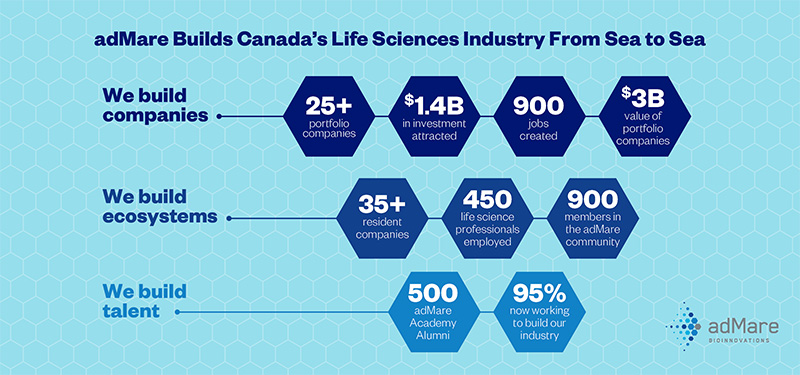By focusing on building companies, building ecosystems, and building talent, we will realize our shared vision of Canadian life sciences leading the world.
COVID-19 spotlighted the need for a strong domestic life sciences industry — both to address and secure the health of Canadians, and drive economic recovery and growth. Governments and other stakeholders are stepping up in historic ways to seize the moment.
For example, the federal government recognized this indispensability with $2.2 billion committed to the life sciences sector in Budget 2021. In addition to increasing public sector support, we have also seen unprecedented private investment — with billions of dollars of venture capital going into Canadian life sciences companies since the pandemic began.
It’s a compelling moment to be part of this ecosystem, and with a wealth of scientific discovery, Canada is primed to be a global leader in life sciences.
It’s a compelling moment to be part of this ecosystem, and with a wealth of scientific discovery, Canada is primed to be a global leader in life sciences. However, to maximize our future successes in the post-pandemic era, we need to double down. Doing so means addressing three pressing problems and focusing all of our energies on three key outcomes:
1. We need more domestic venture capital
Of the billions invested into life sciences by venture capital (VC) funders last year, only 10 percent were from Canadian investors. The good news is that life sciences-focused VC funds in Canada continue to strengthen; with about $1.3 billion raised last year. We also saw a number of the largest fund closings ever. However, foreign limited partners (LPs) comprise the majority of LPs in Canadian VC funds. We certainly welcome foreign direct investment, but to collaborate with those investors, and build a sustainable Canadian ecosystem with them, we must keep building Canadian VCs, too.
2. We need more commercially-focused wet-lab space
This issue is a fundamental roadblock in Toronto, Vancouver, and Montreal. At adMare BioInnovations, we have two multi-tenant Innovation Centres — a 40,000 square foot facility in Vancouver and a 150,000 square foot site in Montreal, where we recently completed a major expansion, essentially doubling the rentable space. With approximately 35 companies residing with us, these Innovation Centres are at capacity. And given the market demand we’ve seen, we could likely fill them twice over.
3. We need more domestic talent
The greatest competitive advantage of our life sciences industry is people. It’s estimated, however, that 65,000 additional workers will be needed to support the bioeconomy by the year 2029. The enormous growth that the existing industry is driving has created a “sweet headache,” a problem of success, a skills gap that we need to address now.
The pressing issues brought on by the pandemic have caused our adMare BioInnovations team to think about how we seize this opportunity to focus on three specific areas: building investable companies, robust ecosystems, and industry-ready talent — and then re-investing our returns back into the Canadian industry to ensure it’s sustained for the long-term.
1. We build companies by partnering with and investing in technology innovators and entrepreneurs — namely academic researchers and emerging Canadian life sciences companies — and bringing our scientific and commercial expertise, specialized R&D infrastructure, and investment capital to the table.
2. We build ecosystems based around physical infrastructure such as our Innovation Centres, which support the growth of Canadian life sciences companies and the development of Canadian innovations by providing move-in-ready lab and office space with shared services and amenities. We also help build the national ecosystem by bringing together and supporting key organizations, as well as producing high-value industry events; and by building connectivity through the adMare Community digital platform.
3. We build talent by training the highly-qualified personnel — from undergrads to industry executives — who will drive the growth of the industry. The adMare Academy provides four distinct program streams: the Executive Institute, the BioInnovation Scientist Program, the Fellowship Program, and the Undergraduate Institute. It has also recently partnered with the Canadian Alliance for Skills and Training in Life Sciences (CASTL) to deliver world-class technical training for Canada’s biopharmaceutical manufacturing sector.
We know what happens when we focus on the interconnected processes of building companies, building ecosystems, and building talent — the results and the data are overwhelmingly clear. We know that this approach works because our 25 portfolio companies have attracted more than $1.4 billion of real risk capital, have a combined value of over $3 billion, and employ almost 1,000 Canadians, and the adMare Academy has trained 500 alumni, 95 perecent of whom are now working to build our life sciences industry.

Even so, no one team alone is going to make our industry a global leader. If we all focus together on these three things — building companies, building ecosystems, and building talent — we will realize our shared vision of Canadian life sciences leading the world.



